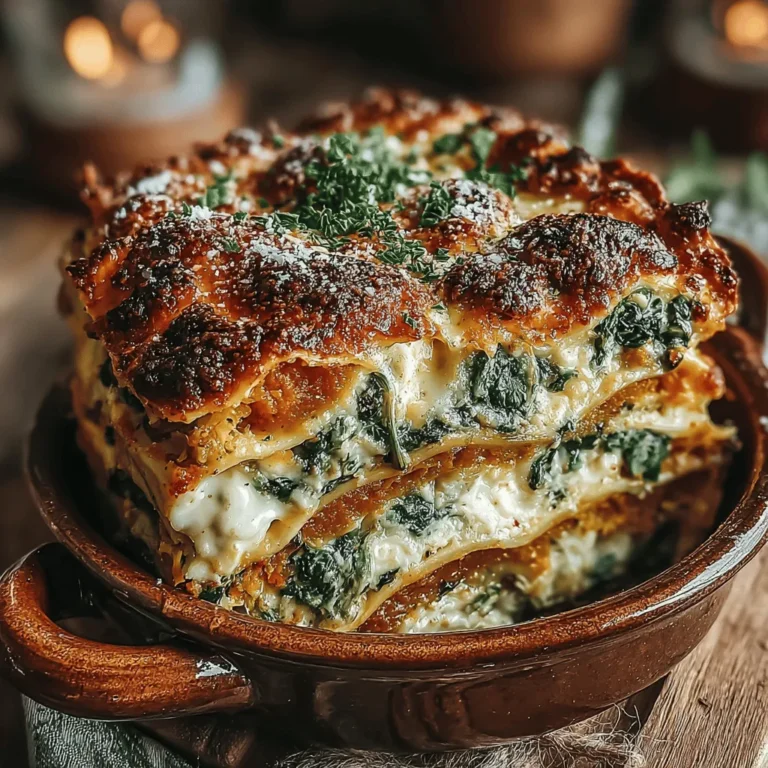Hearty Butternut Squash Lasagna: A Comfort Food Classic
Comfort food holds a special place in the hearts and kitchens of cultures around the world. It evokes feelings of warmth, nostalgia, and satisfaction, often transporting us back to cherished family gatherings or cozy evenings spent at home. From creamy mac and cheese to rich, savory stews, comfort food encapsulates flavors and aromas that nourish not only the body but also the soul. Among these delightful dishes, lasagna stands out as a beloved favorite, known for its layers of pasta, cheese, and an array of fillings. In this article, we are excited to introduce a unique twist on the classic lasagna: Hearty Butternut Squash Lasagna.
This recipe takes the traditional lasagna and infuses it with the natural sweetness and creamy texture of butternut squash, creating a dish that is not only comforting but also packed with nutrients. Butternut squash, with its vibrant orange hue, adds a delightful sweetness that perfectly balances the savory ingredients, while also providing a wealth of health benefits. Rich in vitamins A and C, fiber, and antioxidants, butternut squash serves as a nutritional powerhouse that supports overall health and wellness.
As we embark on this culinary journey, prepare to explore the unique blend of flavors and textures that make this Hearty Butternut Squash Lasagna a standout dish in any meal lineup. The combination of creamy ricotta, melty mozzarella, and nutty Parmesan cheese, alongside the earthy undertones of fresh spinach, creates a harmonious medley that will surely delight your taste buds.
Exploring Butternut Squash: A Nutritional Powerhouse
Before diving into the recipe, let’s take a moment to appreciate the star ingredient: butternut squash. This winter squash is easily recognizable by its bell-like shape and smooth, tan skin. When sliced open, it reveals a vivid orange flesh that is not only visually appealing but also indicative of its rich nutrient content. The flavor profile of butternut squash is a delightful blend of sweetness and nuttiness, making it an excellent addition to both savory and sweet dishes.
Nutritionally, butternut squash is a true gem. A single cup of cooked butternut squash contains approximately 82 calories, making it a low-calorie option for those looking to maintain a healthy diet. It is an excellent source of vitamin A, providing over 300% of the daily recommended intake in just one serving. This vitamin is crucial for maintaining healthy vision, immune function, and skin health. Additionally, butternut squash is rich in vitamin C, which supports the immune system and promotes collagen production for healthy skin.
With its high fiber content, butternut squash aids digestion and helps maintain a healthy gut. Fiber also promotes a feeling of fullness, making it a valuable component in weight management. Furthermore, butternut squash contains essential minerals such as potassium and magnesium, which are vital for heart health and muscle function.
Seasonal availability plays a role in enjoying butternut squash at its peak. Typically harvested in the fall, this squash can be found in grocery stores from late summer through early spring. When selecting butternut squash, look for specimens that feel heavy for their size and have a uniform, matte skin without blemishes or soft spots. A well-selected squash will yield the best flavor and texture for your lasagna.
Ingredients Breakdown
Now that we have a solid understanding of butternut squash and its benefits, let’s examine the other ingredients that come together to create this hearty lasagna. Each component plays a crucial role in building flavor and texture, ensuring a satisfying culinary experience.
– Lasagna Noodles: The foundation of the dish, these sheets of pasta provide structure and a comforting chewiness. For a healthier option, consider using whole wheat or gluten-free noodles.
– Ricotta Cheese: This creamy cheese adds a rich, velvety texture to the lasagna. Its mild flavor pairs beautifully with the sweet butternut squash, allowing the other ingredients to shine. Ricotta is also a good source of protein, making this lasagna a filling dish.
– Mozzarella Cheese: Known for its meltability, mozzarella adds a gooey, stretchy quality to the lasagna. Its mild flavor complements the other cheeses and helps bind the layers together. When choosing mozzarella, opt for fresh or low-moisture varieties for the best results.
– Parmesan Cheese: This aged cheese brings a sharp, nutty flavor that elevates the overall taste of the dish. Sprinkling Parmesan on top of the lasagna before baking creates a deliciously crispy crust.
– Fresh Spinach (or Kale): Adding fresh greens not only enhances the nutritional profile of the lasagna but also brings a pop of color and a slight bitterness that balances the sweetness of the butternut squash. Spinach is rich in iron and vitamins A and C, making it a beneficial addition.
– Herbs and Spices: The use of dried basil, oregano, and nutmeg infuses the lasagna with aromatic flavors. Basil and oregano are classic Italian herbs that contribute to the dish’s savory essence, while nutmeg adds a warm, earthy undertone that enhances the sweetness of the squash.
– Olive Oil: A drizzle of extra virgin olive oil can enhance the overall flavor profile and provide healthy fats that contribute to a satisfying meal.
With a clear understanding of the ingredients and their roles, we are now ready to delve into the cooking process of this Hearty Butternut Squash Lasagna. The combination of flavors and textures will come together to create a dish that is sure to become a beloved addition to your comfort food repertoire.

Preparing the Butternut Squash
Roasting Techniques
To achieve a rich flavor and tender texture in your butternut squash, roasting is the way to go. Start by preheating your oven to 400°F (200°C). Peel the butternut squash using a vegetable peeler, then cut it in half lengthwise and scoop out the seeds. Cut the squash into 1-inch cubes for even roasting.
Seasoning Tips
Toss the squash cubes in a mixing bowl with 2 tablespoons of olive oil, a pinch of salt, and freshly cracked black pepper. For added flavor, you can incorporate a teaspoon of garlic powder or rosemary. Spread the seasoned squash in a single layer on a baking sheet lined with parchment paper. Roasting typically takes 25-30 minutes; you want the squash to be fork-tender and slightly caramelized to enhance its natural sweetness.
Texture Expectations
When roasted correctly, the squash should be soft and slightly golden. This caramelization process not only boosts the flavor but also contributes to the creamy texture you’ll achieve when blending it later. Make sure to let it cool slightly before blending to avoid any burns.
Preparing the Spinach Mixture
Sautéing Garlic and Wilting Greens
While the squash is roasting, focus on the spinach mixture. In a large skillet over medium heat, add a tablespoon of olive oil and one minced garlic clove. Sauté the garlic for about 30 seconds until fragrant, but be careful not to let it brown, as this can impart a bitter taste.
Next, add 5 cups of fresh spinach to the skillet. Stir gently, allowing the greens to wilt down, which should take just about 2-3 minutes. To maintain the vibrant color and nutrients of the spinach, avoid overcooking it. Once wilted, remove the skillet from heat and let it cool briefly.
Avoiding Overcooking
Remember to keep an eye on the spinach as it cooks! Overcooking can lead to a soggy texture that won’t complement the lasagna well. You want the spinach to maintain its vibrant green color and a slight crunch.
Blending the Squash
Achieving the Perfect Creamy Consistency
In a blender or food processor, combine the roasted butternut squash with a splash of vegetable broth (about ¼ cup) to facilitate blending. Blend until smooth and creamy, scraping down the sides as needed. The mixture should be thick yet spreadable; if it’s too thick, add a bit more broth to reach your desired consistency.
Flavor Integration
For enhanced flavor, consider adding a pinch of nutmeg or a tablespoon of maple syrup to the squash puree. Nutmeg brings out the earthy tones of the squash, while maple syrup can enhance its natural sweetness, giving your lasagna a delightful depth of flavor.
Preparation of the Cheese Mixture
Combining Ricotta with Spinach and Parmesan
In a mixing bowl, combine 15 ounces of ricotta cheese, the sautéed spinach, and ½ cup of grated Parmesan cheese. Stir well to ensure even distribution. Season the mixture with salt and freshly cracked black pepper to taste. This cheese mixture will add creaminess and a savory kick to your lasagna.
Ensuring Proper Seasoning
It’s essential to taste and adjust the seasoning of the cheese mixture. The ricotta’s mild flavor can often benefit from a little extra seasoning, particularly if you prefer a bolder taste. Don’t hesitate to add a little extra Parmesan or even a dash of red pepper flakes for some heat.
Assembling the Lasagna
Visual Guide to Layering
Now that you have all your components ready, it’s time to assemble the lasagna. Start with a 9×13 inch baking dish. First, spread a thin layer of marinara sauce on the bottom of the dish to prevent sticking. Then, layer the ingredients as follows:
1. Lasagna Noodles: Arrange a layer of noodles over the sauce.
2. Cheese Mixture: Spread half of the ricotta-spinach mixture evenly over the noodles.
3. Squash Puree: Spoon half of the butternut squash puree on top of the cheese mixture.
4. Marinara Sauce: Add a layer of marinara sauce.
5. Mozzarella Cheese: Sprinkle a layer of shredded mozzarella cheese.
Repeat these layers, finishing with a final layer of noodles, the remaining marinara sauce, and a generous topping of mozzarella cheese.
Importance of the Marinara Sauce
For this lasagna, you can either use homemade marinara sauce or store-bought. If you opt for store-bought, enhance its flavor by simmering it with a splash of red wine, fresh herbs, or sautéed onions and bell peppers. A good marinara sauce is crucial as it complements the creamy layers of cheese and squash beautifully.
Explanation of the Construction of Layers
When building your lasagna layers, aim for balance. Each layer should be evenly distributed to ensure every bite is flavorful. The noodles should be well-covered on all sides to avoid dryness, and the sauce should be sufficient to keep the entire dish moist during baking. This careful layering will result in a beautifully structured lasagna that holds together when served.
Baking and Serving
Baking Instructions
Preheat your oven to 375°F (190°C). Cover the assembled lasagna with aluminum foil to prevent excessive browning. Bake for 25 minutes, then remove the foil and bake for an additional 15-20 minutes until the cheese is bubbly and golden. The total baking time should be around 40-50 minutes.
Tips on Using Aluminum Foil
When using aluminum foil, be careful not to let it touch the cheese layer, as it can stick and pull off the melted cheese. Instead, create a loose tent over the lasagna to allow for even cooking while preventing it from drying out.
Importance of Letting the Lasagna Cool
Once the lasagna is out of the oven, let it cool for at least 15-20 minutes before slicing. This resting time allows the layers to set, making it easier to cut and serve, and enhances the overall presentation. Cutting into a hot lasagna can result in a messy slice that crumbles, so patience is key.
Suggestions for Serving
This hearty butternut squash lasagna pairs wonderfully with a simple side salad or steamed vegetables. A fresh arugula salad with lemon vinaigrette adds a delightful contrast to the richness of the lasagna. Alternatively, a side of garlic bread can complement the meal nicely, providing a satisfying crunch.
Conclusion
The hearty butternut squash lasagna is more than just a comforting dish; it’s a nutritious option that brings warmth and joy to your dining table. With each layer offering its unique flavors and textures, this lasagna exemplifies the beauty of seasonal ingredients and homemade cooking.
Encouraging you to experiment with variations, consider adding other vegetables like mushrooms or zucchini, or even swapping out the cheese for a vegan alternative. The beauty of this dish lies in its adaptability to your personal taste.
Ultimately, sharing this lasagna with family and friends creates memorable experiences filled with laughter and the joy of homemade meals. Whether it’s a cozy weeknight dinner or a festive gathering, this dish is sure to impress and satisfy. Enjoy the process of cooking and the happiness that comes from sharing a meal made with love.


